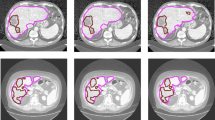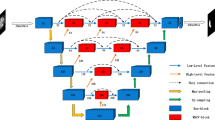Abstract
Manually annotating liver tumor contours is a time-consuming and labor-intensive task for clinicians. Therefore, automated segmentation is urgently needed in clinical diagnosis. However, automatic segmentation methods face certain challenges due to heterogeneity, fuzzy boundaries, and irregularity of tumor tissue. In this paper, a novel deep learning-based approach with multi-scale-aware (MSA) module and twin-split attention (TSA) module is proposed for tumor segmentation. The MSA module can bridge the semantic gap and reduce the loss of detailed information. The TSA module can recalibrate the channel response of the feature map. Eventually, we can count tumors based on the segmentation results from a 3D perspective for cancer grading. Extensive experiments conducted on the LiTS2017 dataset show the effectiveness of the proposed method by achieving a Dice index of 85.97% and a Jaccard index of 81.56% over the state of the art. In addition, the proposed method also achieved a Dice index of 83.67% and a Jaccard index of 80.11% in 3Dircadb dataset verification, which further reflects its robustness and generalization ability.
Graphical abstract










Similar content being viewed by others
References
Bray F, Ferlay J, Soerjomataram I, Siegel RL, Torre LA, Jemal A (2018) Global cancer statistics 2018: Globocan estimates of incidence and mortality worldwide for 36 cancers in 185 countries. CA Cancer J Clin 68(6):394–424
Abdulla AA (2020) Efficient computer-aided diagnosis technique for leukaemia cancer detection. IET Image Process 14(17):4435–4440
Liu T, Liu J, Ma Y, He J, Han J, Ding X, Chen C (2021) Spatial feature fusion convolutional network for liver and liver tumor segmentation from ct images. Med Phys 48(1):264–272
Ronneberger O, Fischer P, Brox T (2015) U-net: Convolutional networks for biomedical image segmentation. In: International conference on medical image computing and computer-assisted intervention, Springer, pp 234–241
Huang H, Lin L, Tong R, Hu H, Zhang Q, Iwamoto Y et al (2020) Unet 3\(+\): A full-scale connected unet for medical image segmentation. In: ICASSP IEEE International conference on acoustics, speech and signal processing (ICASSP), pp 1055–1059. IEEE
Milletari F, Navab N, Ahmadi S-A (2016) V-net: Fully convolutional neural networks for volumetric medical image segmentation. In: Fourth international conference on 3D vision (3DV), pp 565–571. IEEE
Khanna A, Londhe ND, Gupta S, Semwal A (2020) A deep residual u-net convolutional neural network for automated lung segmentation in computed tomography images. Biocybernetics Biomed Eng 40(3):1314–1327
Li X, Chen H, Qi X, Dou Q, Fu C, Heng P-A (2018) Hdenseunet: hybrid densely connected unet for liver and tumor segmentation from ct volumes. IEEE Trans Med Imaging 37(12):2663–2674
Gu Z, Cheng J, Fu H, Zhou K, Hao H, Zhao Y, Zhang T et al (2019) Ce-net: Context encoder network for 2d medical image segmentation. IEEE Trans Med Imaging 38(10):2281–2292
Mesejo P, Valsecchi A, Marrakchi-Kacem L, Cagnoni S, Damas S (2015) Biomedical image segmentation using geometric deformable models and metaheuristics. Comput Med Imaging Graph 43:167–178
Seo H, Badiei Khuzani M, Vasudevan V, Huang C, Ren H, Xiao R, Jia X et al (2020) Machine learning techniques for biomedical image segmentation: an overview of technical aspects and introduction to state-of-art applications. Med Phys 47(5):e148–e167
Kushnure DT, Talbar SN (2021) Ms-unet: A multi-scale unet with feature recalibration approach for automatic liver and tumor segmentation in ct images. Comput Med Imaging Graph 89:101885
Jin Q, Meng Z, Sun C, Cui H, Su R (2020) Ra-unet: A hybrid deep attention-aware network to extract liver and tumor in ct scans. Front Bioeng Biotechnol 1471
Li Y, Song S, Sun Y, Bao N, Yang B, Xu L (2022) Segmentation and volume quantification of epicardial adipose tissue in computed tomography images. Med Phys 49(10):6477–6490
Zhou Z, Rahman Siddiquee MM, Tajbakhsh N, Liang J (2018) Unet++: A nested u-net architecture for medical image segmentation. In: Deep learning in medical image analysis and multimodal learning for clinical decision support, Springer, pp 3–11
Cheng F, Chen C, Wang Y, Shi H, Cao Y, Tu D et al (2020) Learning directional feature maps for cardiac mri segmentation. In: Medical image computing and computer assisted intervention–MICCAI 2020, Springer, pp 108–117
Wang K, Zhang X, Zhang X, Lu Y, Huang S, Yang D (2022) Eanet: Iterative edge attention network for medical image segmentation. Pattern Recogn 127:108636
Hu J, Shen L, Sun G (2018) Squeeze-and-excitation networks. In: Proceedings of the IEEE conference on computer vision and pattern recognition, pp 7132–7141
Woo S, Park J, Lee JY, Kweon IS (2018) Cbam: Convolutional block attention module. In: Proceedings of the european conference on computer vision (ECCV), pp 3–19
Schlemper J, Oktay O, Schaap M, Heinrich M, Kainz B et al (2019) Attention gated networks: Learning to leverage salient regions in medical images. Med Image Anal 53:197–207
Hou Q, Zhou D, Feng J (2021) Coordinate attention for efficient mobile network design. In: Proceedings of the IEEE/CVF conference on computer vision and pattern recognition, pp 13713–13722
He K, Zhang X, Ren S, Sun J (2016) Deep residual learning for image recognition. In: Proceedings of the IEEE conference on computer vision and pattern recognition, pp 770–778
Huang G, Liu Z, Van Der Maaten L, Weinberger KQ (2017) Densely connected convolutional networks. In: Proceedings of the IEEE conference on computer vision and pattern recognition, pp 4700–4708
Szegedy C, Ioffe S, Vanhoucke V, Alemi AA (2017) Inceptionv4, inception-resnet and the impact of residual connections on learning. In: Thirty-first AAAI conference on artificial intelligence
Jadon S (2020) A survey of loss functions for semantic segmentation. In: IEEE Conference on computational intelligence in bioinformatics and computational biology (CIBCB), pp 1–7. IEEE
Umer J, Irtaza A, Nida N (2020) Maccai lits17 liver tumor segmentation using retinanet. In: 2020 IEEE 23rd International multitopic conference (INMIC), pp 1–5. IEEE
Soler L, Hostettler A, Agnus V, Charnoz A, Fasquel J, Moreau J, Osswald A et al (2010) 3d image reconstruction for comparison of algorithm database: A patient specific anatomical and medical image database. IRCAD, Strasbourg, France, Tech. Rep, 1(1)
Zhang C, Hua Q, Chu Y, Wang P (2021) Liver tumor segmentation using 2.5d uv-net with multi-scale convolution. Comput Biol Med 133:104424
Wilson AC, Roelofs R, Stern M, Srebro N, Recht B (2017) The marginal value of adaptive gradient methods in machine learning. Adv Neural Inf Process Syst 30
Pang S, Du A, Orgun MA, Wang Y, Yu Z (2021) Tumor attention networks: Better feature selection, better tumor segmentation. Neural Netw 140:203–222
Zhang Y, Liu H, Hu Q (2021) Transfuse: Fusing transformers and cnns for medical image segmentation. In: International conference on medical image computing and computer-assisted intervention, Springer, pp 14–24
Sinha A, Dolz J (2020) Multi-scale self-guided attention for medical image segmentation. IEEE J Biomed Health Inform 25(1):121–130
Yang Z, He X, Gao J, Deng L, Smola A (2016) Stacked attention networks for image question answering. In: Proceedings of the IEEE conference on computer vision and pattern recognition, pp 21–29
Silversmith W (2021) cc3d: Connected components on multilabel 3d images. Nat Methods
Acknowledgements
The first author would like to express his sincere gratitude to Professor Shuwei Mao for his guidance and encouragement over the years.
Author information
Authors and Affiliations
Corresponding author
Ethics declarations
Competing interests
The authors declare no competing interests.
Additional information
Publisher's Note
Springer Nature remains neutral with regard to jurisdictional claims in published maps and institutional affiliations.
Rights and permissions
Springer Nature or its licensor (e.g. a society or other partner) holds exclusive rights to this article under a publishing agreement with the author(s) or other rightsholder(s); author self-archiving of the accepted manuscript version of this article is solely governed by the terms of such publishing agreement and applicable law.
About this article
Cite this article
Wang, Z., Zhu, J., Fu, S. et al. Context fusion network with multi-scale-aware skip connection and twin-split attention for liver tumor segmentation. Med Biol Eng Comput 61, 3167–3180 (2023). https://doi.org/10.1007/s11517-023-02876-1
Received:
Accepted:
Published:
Issue Date:
DOI: https://doi.org/10.1007/s11517-023-02876-1




